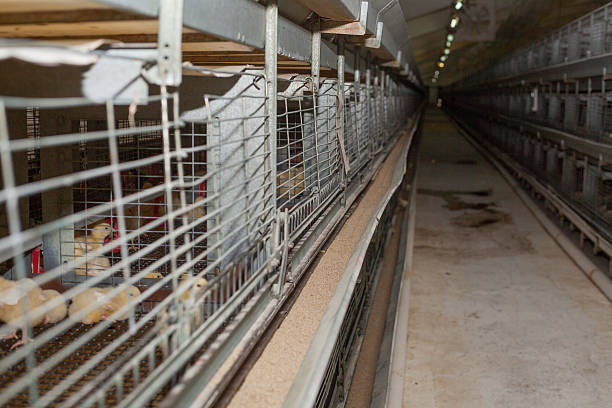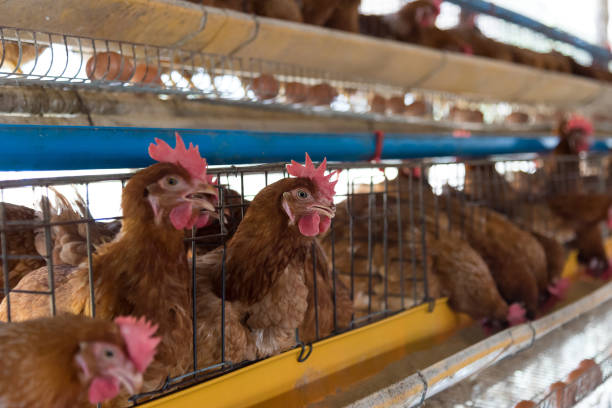A Beginner’s Guide to Chicken Farm Planning in Africa: Focus on Cages
A Beginner’s Guide to Chicken Farm Planning in Africa: Focus on Cages
Embarking on a chicken farming venture in Africa is an exciting prospect, full of potential for profit and contributing to local food security. However, like any agricultural endeavor, success hinges on careful planning and execution. This guide is designed to walk you through the crucial steps of planning your chicken farm, with a particular focus on selecting and utilizing chicken cages to maximize efficiency and profitability.
Understanding the African Poultry Landscape
Before diving into the specifics of chicken farm planning, it’s essential to understand the unique challenges and opportunities presented by the African poultry market. Factors such as climate, local feed availability, market demand, and infrastructure all play a significant role in the success of your farm.
Market Demand: Conducting thorough market research is the first step. What kind of poultry products are in demand in your region? Are consumers more interested in eggs or meat? What are the preferred breeds and sizes of chickens? Understanding the market you’re targeting will inform your choice of breeds, production methods, and overall farm size.
Climate Considerations: Africa’s diverse climates present both challenges and opportunities. In hotter regions, proper ventilation and cooling systems are essential to prevent heat stress in your chickens. In colder regions, you’ll need to provide adequate insulation and heating to maintain optimal laying or growth conditions.
Feed Availability and Cost: Feed constitutes a significant portion of your operating costs. Investigating local feed sources, negotiating with suppliers, and even considering growing your own feed ingredients can help to drastically reduce expenses.
Infrastructure: Access to reliable electricity, water, and transportation networks is crucial. Consider the availability of these resources when selecting a location for your farm.
Regulations and Permits: Ensure you are aware of all local regulations and permitting requirements for chicken farming. Compliance with these regulations is essential for operating legally and avoiding fines or disruptions.
Choosing the Right Chicken Breed
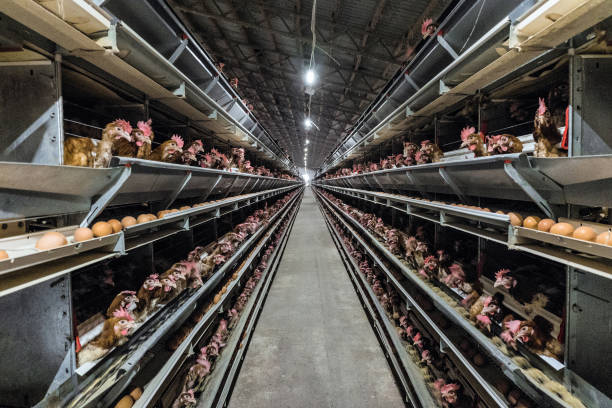
The breed of chicken you choose will depend largely on your target market. Here’s a breakdown of some popular options:
Layers (Egg Production):
Hy-Line Brown: Known for their high egg production and adaptability to various climates.
Lohmann Brown: Another popular choice for egg production, known for their hardiness and relatively low feed consumption.
ISA Brown: A prolific layer with good egg quality.
Broilers (Meat Production):
Cobb 500: A fast-growing breed with excellent feed conversion rates.
Ross 308: Another popular broiler breed known for its rapid growth and efficient meat production.
Dual-Purpose Breeds:
Rhode Island Red: A heritage breed that produces a decent number of eggs and provides a good amount of meat.
Plymouth Rock: Another reliable dual-purpose breed known for its hardiness and adaptability.
Selecting the Right Chicken Cage System
Chicken cages are a popular choice for poultry farmers in Africa, particularly for laying hens and broilers. They offer several advantages over free-range systems, including:
Increased Space Efficiency: Cages allow you to house more chickens in a smaller space, maximizing your production potential.
Improved Hygiene: Cages can help to keep chickens cleaner and reduce the spread of disease.
Easier Management: Cages make it easier to monitor individual chickens, collect eggs, and provide feed and water.
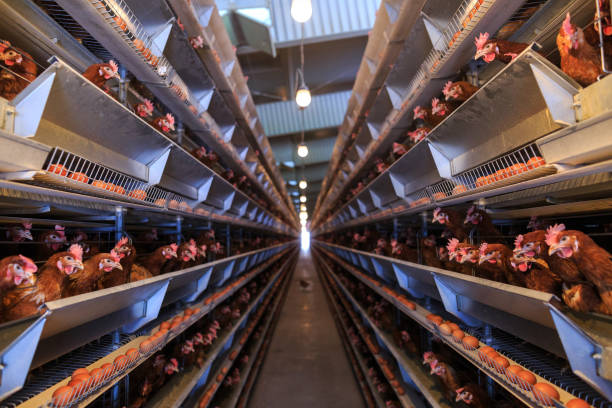
Reduced Feed Waste: Cages can help to minimize feed waste, as chickens have less opportunity to scatter or contaminate feed.
Predator Protection: Cages provide a secure environment for chickens, protecting them from predators such as foxes, dogs, and birds of prey.
There are several types of chicken cage systems available, each with its own advantages and disadvantages:
Layer Cages: Designed specifically for laying hens, these cages typically feature sloping floors that allow eggs to roll forward for easy collection. They often include automatic feeding and watering systems. Layer chicken cages are usually A-type or H-type cages.
Broiler Cages: Designed for raising meat chickens, these cages are typically larger and more spacious than layer cages. They need to be sturdy enough to accommodate the rapid growth of the meat chickens.
Battery Cages: Generally refers to a system that houses multiple chickens in small, individual compartments. While they were once common, battery cages have come under increasing scrutiny due to animal welfare concerns and are banned in some regions. Consider alternative systems with greater space and enrichment.
A-Frame Cages: These cages are arranged in an A-shape, with the feed and water troughs located along the sides. They are a relatively simple and cost-effective option.
H-Frame Cages: These cages are arranged in an H-shape, with multiple tiers of cages stacked on top of each other. They offer excellent space utilization but may require more sophisticated ventilation and manure removal systems.
Factors to Consider When Selecting Chicken Cages:
Material: Cages are typically made from galvanized steel or wire mesh. Galvanized steel is more durable and resistant to rust, which is essential in humid climates.
Size and Capacity: Choose cages that are appropriately sized for the breed of chicken you are raising and the number of chickens you intend to house. Overcrowding can lead to stress, disease, and reduced production.
Ventilation: Proper ventilation is crucial to maintain a healthy environment for your chickens. Ensure that the cages are designed to allow for adequate airflow.
Manure Removal: Consider how you will remove manure from the cages. Manual removal can be labor-intensive, while automatic manure removal systems can significantly reduce labor costs.
Feeding and Watering Systems: Choose cages that are compatible with automatic feeding and watering systems. These systems can save you time and effort and ensure that your chickens always have access to fresh food and water.
Durability and Maintenance: Choose cages that are durable and easy to maintain. Regular cleaning and maintenance will help to extend the lifespan of your cages and prevent the spread of disease.
Site Selection and Farm Layout
Choosing the right location for your chicken farm is crucial for its success. Consider the following factors:
Accessibility: The farm should be easily accessible by road, allowing for the efficient transport of feed, chickens, and eggs.
Water Availability: A reliable source of clean water is essential for drinking, cleaning, and sanitation.
Electricity Supply: A stable and affordable electricity supply is necessary for lighting, ventilation, and operating equipment.
Proximity to Markets: Locate your farm close to your target markets to minimize transportation costs and ensure that your products reach consumers quickly.
Distance from Residential Areas: To avoid noise complaints and potential conflicts with neighbors, locate your farm away from residential areas.
Topography and Drainage: Choose a site with good drainage to prevent water from accumulating around the chicken houses, which can create unsanitary conditions.
Farm Layout:
A well-planned farm layout can improve efficiency and biosecurity. Consider the following elements:
Chicken Houses: Orient the chicken houses in an east-west direction to minimize direct sunlight exposure and maintain a more consistent temperature.
Feed Storage: Locate the feed storage area close to the chicken houses for easy access.
Egg Collection and Processing Area: Designate a specific area for collecting, cleaning, and grading eggs.
Manure Management Area: Establish a designated area for storing and composting manure.
Biosecurity Measures: Implement biosecurity measures to prevent the introduction and spread of disease. This may include fencing, foot baths, and strict visitor protocols.
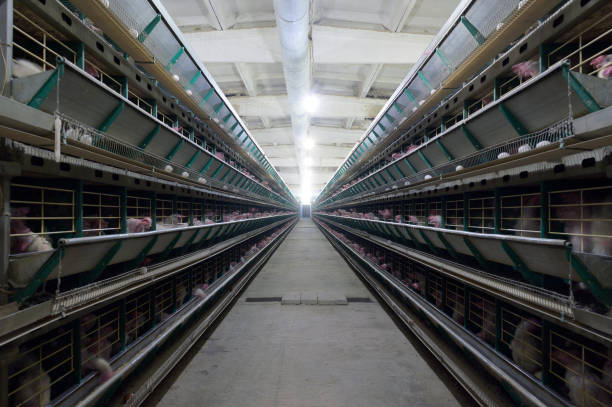
Feeding and Watering
Providing your chickens with a balanced and nutritious diet is essential for optimal growth and egg production. Your chickens need:
Commercial Feed: Purchase high-quality commercial feed specifically formulated for the breed and age of your chickens.
Supplementary Feed: Consider supplementing their diet with locally available ingredients such as maize, soybeans, and sunflower seeds to reduce feed costs.
Clean Water: Ensure that your chickens always have access to fresh, clean water.
Feeding and Watering Systems:
Automatic Feeders: Automatic feeders can dispense feed at regular intervals, ensuring that your chickens always have access to food.
Nipple Drinkers: Nipple drinkers provide a clean and efficient way to provide water to your chickens. They also help to reduce water wastage.
Bell Drinkers: Bell drinkers are another popular option for providing water to chickens. They are relatively inexpensive but require frequent cleaning to prevent contamination.
Health Management and Biosecurity
Maintaining the health of your chickens is crucial for preventing disease outbreaks and minimizing losses.
Vaccination Programs: Implement a comprehensive vaccination program to protect your chickens from common diseases such as Newcastle disease, infectious bronchitis, and fowl pox.
Regular Health Checks: Conduct regular health checks to identify and treat sick chickens promptly.
Biosecurity Measures: Implement strict biosecurity measures to prevent the introduction and spread of disease. These may include:
Controlling Access: Restricting access to the farm to authorized personnel only.
Foot Baths: Providing foot baths at the entrance to each chicken house.
Disinfection: Regularly disinfecting equipment and surfaces.
Quarantine: Isolating new chickens before introducing them to the flock.
Waste Management
Proper waste management is essential for maintaining a clean and sanitary environment and preventing environmental pollution.
Manure Collection: Collect manure regularly and store it in a designated area.
Composting: Compost the manure to create a valuable fertilizer for your crops.
Biogas Production: Consider using manure to produce biogas, a renewable energy source.
Financial Planning and Management
Before starting your chicken farm, it’s essential to develop a comprehensive financial plan.
Start-up Costs: Estimate the costs of purchasing land, building chicken houses, buying cages, and acquiring equipment.
Operating Costs: Estimate the costs of feed, water, electricity, labor, and veterinary services.
Revenue Projections: Estimate your potential revenue from egg or meat sales.
Profitability Analysis: Analyze your costs and revenue to determine the profitability of your farm.
Funding Sources: Identify potential sources of funding, such as loans, grants, or personal savings.
Conclusion
Planning a successful chicken farm in Africa requires careful consideration of various factors, including market demand, climate, breed selection, cage systems, site selection, health management, and financial planning. By following the steps outlined in this guide, you can increase your chances of building a profitable and sustainable poultry business that contributes to the growing demand for poultry products in Africa. Remember that continuous learning and adaptation are key to long-term success in the dynamic agricultural landscape. Good luck!




